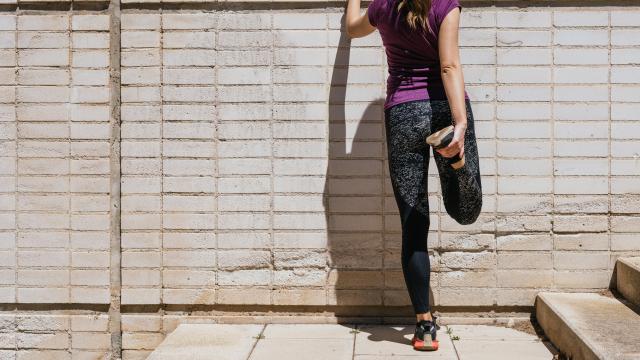When should you stretch? As with many aspects of fitness, there are different schools of opinion, and I’ve studied, as it were, with each of them. I’ve stretched before workouts because that’s what everybody else does; I’ve given up pre-workout stretching because I felt the cons outweighed the pros; and more recently I’ve come to appreciate some of the ways stretching can help to make a workout better. So let me share what I’ve learned.
Stretching before a workout isn’t mandatory
Let’s bust a few myths, lightning round-style: Static stretching (where you hold a stretch for, say, 30 seconds) doesn’t “warm up” your muscles; actually moving around does that. Stretching beforehand does not reduce your chance of injury during a workout. And it does not change how sore you may feel afterward. (We debunk more on these myths here.)
If you currently don’t stretch before your workouts and you’re happy with how your workouts are going, you’re good. No need to add anything.
Dynamic stretching is a good option before a workout
What should you do, then, instead of stretching? Consider the purpose of a warmup: It needs to prepare you for the day’s work. A good warmup should:
- Get your muscles literally warm, like in the temperature sense.
- Make you move your body in a way similar to what the day’s workout will require, or even in an exaggerated version of those movements.
- Allow you to practice the skill involved in those movements (for example, squatting the empty bar before you begin adding weight).
Dynamic stretching is usually recommended over static stretching for the beginning of a workout, because it does the first two of these things at once. Let’s say you’re going to run; doing a few rounds of high knees and butt-kickers will get your heart rate up, your blood flowing, and your quads and hamstrings limber and ready to move freely.
Foam rolling or other self-massage techniques are also recommended here. They stretch your muscles in one spot at a time without requiring you to really sink into a stretch. Static stretching can slightly reduce your maximum strength or power output; dynamic stretching gives you less of a stretch and more of the other warmup advantages, so it’s a good option.
Targeted static stretching can be good before a workout, too
Static stretching for no reason doesn’t deserve a place in a pre-workout routine. But many of us have a good reason to do static stretching before we get into our other exercises.
For example, if your ankles tend to be stiff, stretching your ankles and calves before a squat workout can help you to be able to squat deeper. This might take the form of dedicated ankle stretches, or you might just grab the barbell and sit at the bottom of the squat for 30 seconds or so, giving your Achilles tendons a chance to relax.
Or take my shoulders, for example. A physical therapist once advised me to stretch my shoulders before workouts that involve overhead movements. I was sceptical at first, but she’s right: I have an easier time supporting the bar in the right position if I’ve taken the time to do some shoulder stretches first.
Or, for a more extreme example, what do ballet dancers do as they get into their practice for the day? They might start with moves to get physically warm, but there will usually also be a nice long stretching segment to help them limber up before attempting the moves that require the greatest range of motion.
Stretching after a workout is a great time to work on flexibility
Finally, we come to the end of a workout. If you want to work on your flexibility for the future, the end of a workout is a great time to do that. After a workout, your muscles are warm and already somewhat limbered up. That will help you to be able to get deeper into your stretches. (If you do a standalone stretching session, a bit of movement such as cardio or dynamic stretching before you sit down to stretch can also serve this purpose.)
You’re also free to stretch as deeply as you want without worrying about whether stretching too much will affect what you do next. So if you have a flexibility routine you’re working on, this is the perfect time.

Leave a Reply
You must be logged in to post a comment.